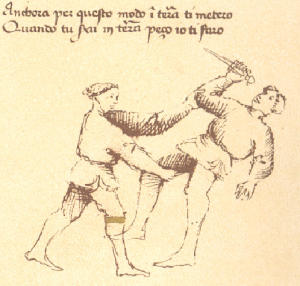

This weekend, along with nearly a score of other hardy souls, I spent two long days learning from a gentleman who's spent years translating and interpreting a treatise from 1410 on various combat techniques.
We got a chance to learn and practice period wrestling, dagger, baton, short sword and long sword; and we learned techniques of armored combat, with sword, pole-axe and spear.
It threw into sharp focus how inauthentic SCA combat really is. Many of the unarmored swordfighting techniques found in Flos Duellatorum are prohibited by SCA rapier combat rules (such as deliberately disarming your opponent, binding his arms, throwing him, or — with certain blade types — grasping his blade). And swinging a sword, at least in Fiore dei Liberi's manual, was simply not done in armor. (Why? Because unlike in the SCA — where a good swing can count as a killing blow — in the real world, armor was proof against cutting swings, as well as nearly every thrust. The only way to kill an armored opponent was to stab an unprotected place: the face, under the arm — if you could thrust strongly enough to get through the mail worn under the plate armor — behind the knees, or the buttocks.) Nearly all of the armored sword techniques involved holding your sword with one hand on the hilt, and the other halfway up the blade, unless you were thrusting from a certain position. (I'm definitely going to have to check out other fighting treatises and Fechtbücher to see if they're similar.)
But the techniques we learned were absolutely astounding. They were elegant in their simplicity; sometimes brutal, sometimes comical (grab your opponent's elbow and push him backwards, then simply grab his near knee and pull — and down he goes).

SCA fencing would be several dozen orders of magnitude cooler if they did stuff like this, instead of crap like rubber band guns and "le poulet gauche"; judging from some of the comments made by the heavy-weapons fighters (such as their scheming to get some of the moves deemed legal), it seemed just as cool for their idiom.
It's just impossible to convey in words how sweet this stuff was; how magical it seemed to just move your hand a certain way, step backwards, and watch his sword or dagger fly out of his grip. All weekend, I was just shaking my head and smiling in wonderment at how simple the moves were, yet how fantastic were the results.
Take that, lovers of kung-fu! There's a new style in town, and it's bad-ass. If Westerner's weren't such technology whores, abandoning these forms for guns, you would probably see "Fiore vs. Karate" matches.
There are certainly a number of simple, elegant and effective techniques of swordplay that are period, but are not used in SCA fencing. I believe the reason for this is due to the fact that many of them are dangerous. Period fencing, particularly in Trimaris, already has an record of period fencing injury, due more to a poor quality blade and once permissive marshalls.
I'm ranting, sorry. Period fencing has improved quite a bit in terms of safety, but I agree wholeheartedly on the sheer goofiness of rubber band guns.
By the by, can you recommend any good books on British Navy? I've run across fiction of course, like the O'Brian novels and the Sharpe books, but I was looking for a more practical and historical guide to the period and the procedures.
But there were plenty of non-dangerous moves, too. For example, many of the moves involved grasping one's opponent's wrist or elbow in order to create an opening — forbidden by SCA rules. A lot of them involved grasping the opponent's blade (okay if you're using a Schlager or Fiberglas blade, but disallowed with the epée [Why? And why are push cuts disallowed with epées {and foils, in kingdoms which use them}?]).
Certain disarms would probably damage fingers or wrists if the victim had a guard that would bind his hand, but a simple cross-hilt dagger or sword just pops out of the victim's grip like it was oiled.
Ah well. British Navy! For a great overview of the Navy in the mid-1800s, The Wooden World is an excellent resource; it goes into some detail on the institutions of the Navy, shipboard life, history, etc. I'd be happy to loan you my copy.
Naval Documents of the American Revolution is an immense multivolume set of books, contained in many libraries (including USF), simply crammed full of letters and reports, many of which are from the British side. A lot of great information can be gleaned from it, depending on what you're looking for.
There are also quite a number of period nautical books available on microfilm at the USF library; I printed out two gunnery manuals (here and here) which are from the seventeenth century, but still contain plenty of good information (the second also covers navigation and how to manage a fight at war); there were quite a few more on other topics that I haven't had a chance to look at yet.
The reasoning I believe is that schlager blades are harder to break, and the nature of a push cut is such that they think people would be in more danger with foils and epees (due to prior incidents with broken blades - particularly in the Olympics). Draw cuts are probably the safest kind of strike a fencer can make, since you're pulling away from the body, but they're not quite as flashy or impressive.
Personally, I'll take an epee over a schlager any day of the week, but I've never quite trusted those stage blades.
The Markland group uses a system that allows for open-hand grappling in rapier, so long as you don't touch the persons face or neck and never close your fingers around any part of your opponent, and you can actually grasp a blade if you're wearing a mail gauntlet.
Thanks for the info on British Navy.
I've never used a Schlager, but I'm thinking about giving it a try (especially if it permits fighting in a more authentic style). I've always preferred the epée (even in the East Kingdom, where foils tended to be more common, at least when I was living there), but it wasn't invented until the 18th century.
And I also need to look into the dagger. It surprised me how utterly defenseless a swordsman is against someone carrying only a dagger.
During "Goldeneye", which Lisa and I watched last night, 007 was fighting a turncoat 00 agent hand-to-hand. Bond was being choked out and I turned to Lisa and said "Look at that; all he has to do is put one arm inside, one arm outside, and twist a half-step back to the left and he's out."
It's amazing just how effective Fiore's system would be in action. Of course to me it's like billards: it makes sense in my head, but making my body do it is another story.
The instructor showed us a series of sword positions that were intended to be practiced in a smoothly flowing sequence from one to another, much like an Eastern martial arts kata.